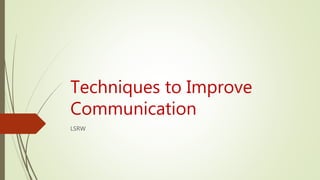
Listening skill
- 2. Skills for Communication Receptive Skills 1) Listening 2) Reading Expressive Skills 1) Speaking 2) Writing
- 3. Techniques to Improve Communication Listening 45% Speaking 30% Reading 16% Writing 09% Average time spent by an executive everyday.
- 5. Listening Skills What is listening? Barriers /Reasons for poor listening. Types of listening.
- 6. Listening is a Process of Receiving and Interpreting the Spoken Word/s.
- 7. ii. Process of Listening: #Stages: 1. Sensing 2. Interpreting 3. Evaluating 4. Remembering 5. Responding
- 8. What is listening? Listening is the process of receiving, interpreting and reacting to a message received from the speaker. No communication process is complete without listening.
- 9. Reasons for poor listening 1) No training is available Training sessions are available for speaking, reading and writing.
- 10. Reasons for poor listening 2. Thought speed is more than speaking speed. We speak @ 125 words per minute, whereas, Our mind has capacity to comprehend @ 400-500 words per minute. Mind has 75% more capacity to interpret the speech.
- 11. Reasons for poor listening 3. We are inefficient listeners According to Gail Miller, Prof. at Washington University, study has shown that whatever human being has listened is erased by the time. E.g. We can remember only 50% of what is said instantly, within 48 hours of timing we dropped another 50% , to the final level we can retain only 25% of what is said.
- 12. Reasons for poor listening 4. Poor listening habits 4.1 Rehearsing. Some people listen only until they decide that they want to say something, then they quit listening. They start to rehearse what they want to say and wait for the opportunity to jump in and talk. E.g. in G.D. most students do it.
- 13. Reasons for poor listening 4.2 Interrupting The listener does not wait to determine the complete meaning, but interrupts so forcefully that the speaker stops in the mid sentence. E.g. In debate mostly it happens.
- 14. Reasons for poor listening 4.3 Hearing only what is expected. People hear only what they expect to hear alternatively they refuse to hear what they do not want to hear. E.g. It mostly happens when informal meetings are arranged by the organization.
- 15. Reasons for poor listening 4.4 Listening for disagreement Some listeners listen just to have a chance of disagreement to attack someone verbally. If disagree with somebody, we follow our own train of thought and spend more time to develop counter arguments & no longer listen to the speaker’s additional comments. E.g. quarrels between two employees.
- 16. Reasons for poor listening 4.5 Listening only for facts Many of us listen only for facts and while we may recall some isolated facts, we may miss the primary idea the speaker is trying to convey. E.g. Brainstorming session in Goa.
- 17. Types of listening 1.Active listening Is a kind of listening where the listener pays utmost attention to understand the every details made by speaker. Involves verbal feedback, asking questions. The decoding process on the part of listener is accurate and complete. E.g. Understanding of topic from subject teacher, getting the proper information.
- 18. Types of listening 2.Passive listening Is when the listener is paying a partial attention to the listening is known as passive listening. Listener has divided attention and not fully concentrating on the process of listening. Misinterpretation of the message & confusion is very common in this type of listening. E.g. Listening music while writing assignments or cleaning the house.
- 19. Types of listening 3. Appreciative listening Is listening for deriving aesthetic pleasure. E.g. when we listen to comedian, musician or entertainer. Can be active when the listener is genuinely interested in the subject matter.
- 20. Types of listening 4. Empathetic listening. In empathetic listening, the listener has to appreciate the speaker’s emotions, circumstance, mindset, and perspective and be able to provide emotional and moral support . Empathy means feeling the same as the other person. E.g. practiced by nurses, a psychiatrist
- 21. Types of listening 5. Comprehensive listening Is to interpret, comprehend and understand the message. Is needed in the classroom when students have to listen to lectures. When someone is giving you directions to find the location of the place.
- 22. Types of listening 6. Critical listening Also known as evaluative, judgmental, or interpretive listening, involves analyzing, evaluating & judging what is being said. In this listening we tend to judge people's saying, the truth and reality in their speaking. Is applicable when the other person is trying to persuade. E.g. listening to salesperson, corporate meetings, meetings with potential customers.
- 23. Types of listening 7. Superficial listening Is hearing or passive listening One pretends to be listening by giving fake expressions to avoid offending the speaker. E.g. When somebody is forced to attend a guest lecture on an area that is not of one’s interest.
- 24. Types of listening 8. ‘You’ viewpoint Stephen Covey says, ‘Seek first to understand, and then be understood’. Give other person more importance and avoid forcing our opinion, we can listen better. Using ‘you’ viewpoint we can boost the confidence of the speaker, making him or her more open to communication. E.g. Counselors, Psychiatrist practice this.
- 25. Techniques to Improve Listening 1. Make an effort to concentrate 2. Stop talking while listening 3. Encourage the speaker 4. Avoid distractions 5. Keep an open mind 6. Listen for ideas-not just words 7. Watch for non-verbal communication 8. Take notes
